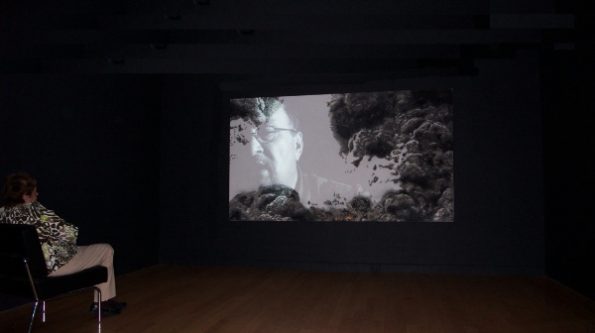Search
To search for an exact match, type the word or phrase you want in quotation marks.
A*DESK has been offering since 2002 contents about criticism and contemporary art. A*DESK has become consolidated thanks to all those who have believed in the project, all those who have followed us, debating, participating and collaborating. Many people have collaborated with A*DESK, and continue to do so. Their efforts, knowledge and belief in the project are what make it grow internationally. At A*DESK we have also generated work for over one hundred professionals in culture, from small collaborations with reviews and classes, to more prolonged and intense collaborations.
At A*DESK we believe in the need for free and universal access to culture and knowledge. We want to carry on being independent, remaining open to more ideas and opinions. If you believe in A*DESK, we need your backing to be able to continue. You can now participate in the project by supporting it. You can choose how much you want to contribute to the project.
You can decide how much you want to bring to the project.

“Do you have time?” gives a voice to those who usually don’t have one. Segregated in the streets and flattened by the conditions of late capitalism, they don’t generally enter museums or even give their opinion. A homeless David Kleinman relates his own vision of the history of the USA. A revision that is immediately labelled Marxist. Especially when it comes from an Argentine artist who dares to talk about the USA.
On entering one of the rooms of the Aldrich Contemporary Art Museum, the spectator will feel overwhelmed by the smell of saltpeter, sulphur and coal from a burnt painting, onto which is projected a black and white film. Perhaps the stench will provoke a strange sensation, mixed up with the perception of something that is difficult to recognise but which their unscrupulous investments implement. The miasma will evoke a series of opposing figures: 4 July, 11 September and the war in Iraq. Amongst the visitors to the museum in the city of Ridgefield there is usually a handful of financiers, who contribute by way of large investments to the opening of “new markets” and, perhaps without knowing it, to the fall of governments. These are the men who manipulate the flow of global finance, and consequently, control the distribution of subjects in space and time. These men and their families know that time is money, so it is unlikely that they will have two hours available to watch and listen to the filmed portrait of David Kleinman, an unemployed, 63 year old, New Yorker, relating his personal vision of the unofficial history of the United States. This video, filmed by the artist Judi Werthein, is projected onto a cloud of ash and explosions painted in burnt gunpowder by the artist Tomás Espina. Do you have time? is the narration of a story and the setting of a scene of an unemployed person from Queens, in the form of a talking head, in an oneiric and ethereal landscape. The authenticity of the story is coupled with the lyricism of the ascending motion of the cloud of smoke that suggests an explosion in the sky.
David Kleinman studied history and philosophy at the University of Wisconsin during the decade of the seventies, but abandoned his academic aspirations in order to work and scrape a living during the petrol crisis. Even though he has dedicated 30 years of his life to the printing industry, he has never lost his passion for history. A true bookworm, Kleinman divided his time between work and family on the one hand and autodidactic reading on the other. During the recession and the world crisis of 2008, Kleinmain was laid off. Aged 59 and with no possibility of gaining employment in a country with almost 10% unemployment, Kleinman threw himself into reading and waiting for retirement. Unemployed and never having been able to become a historian, he has all the time in the world to narrate his version of the history of the United States. Armed with facts and details, he talks about the racist ideologies of the settlers of Massachusetts in the 17th century, the massacre of the Mystic river, the genocide of the aboriginal populations and of slavery. These topics are submitted to scrutiny and freely associated with current problems, so that Kleinman passes from Thomas Paine and George Washington to Richard Nixon and George W. Bush. Kleinman is a Marxist and a fervent critic of the United States, however, at the same time, he conceives of this country and its constitution as one of the greatest social experiments in humanity, one that seduced Alexis de Tocqueville and even Karl Marx. According to Kleinman, the United States is a strange combination of materialism and idealism promoting self-government, democracy and the search for happiness – as stated in the 4th article of the constitution. Kleinman defends the ideals and praxis of the 1776 Revolution, which he considers incomparable with the French Revolution – for the seeds of terror of Maximilian Robespierre and the imperial caprices of Napoleon Bonaparte. However, the American experiment was never brought to fruition, being left subjugated to the yoke of corporations and the control of society. From the idea of self-government and happiness it passed to the control of the internet and a military State that instigates wars beyond its political sovereignty.
Whether it is with feeble arguments, based on the ideology of liberty and democracy, the governors of the United States justify invasions, massacres and coups d’état. In their way, the majority of the citizens approve of the wars in the Middle East and the huge military budget (20% del GDP) that is paid for with 40 % of their income. “A contrario sensu”, some of the spectators that attended the opening accused David Kleinman of being a communist and objected to the possibility that an Argentine artist could express an opinion about the history of a country that isn’t her own. Implausible chauvinism from a nation constructed integrally out of immigration. Paradoxical asymmetry of those who can talk and invade other countries but can’t tolerate foreign critics. Denying the right to express an opinion they decided not to listen: adding up the limited time that the public generally dedicates to the contemplation of art works and the irritation caused by the words of Kleinman, the majority of the spectators didn’t last more than 5 minutes in front of the video. The reply to the title of the piece, “Do you have time?” is often a categorical and unspoken “no”.
The work appeals to the spectator, inciting him to revisit the history of the United States and to read the constitution that is placed on two tables adjacent to the chairs and sofas in the projection room. The conditions are provided, but the ritual of museum visits is established: a light stroll and a passing gaze that circumnavigates the works. An unemployed person who has the free time to tell a story comes up against an audience that doesn’t have time to listen to him. It is known that contemporary art is just one more chink in the cultural industry and that western society is heading for another century without aura. However, “Do You Have Time?” requires the spectators to leave behind their role of audience and to transform themselves into interpreters who elaborate, translate and appropriate «history», the memory of what they were, the perception of the present and what they imagine for the future. According to Rancière, an emancipated community is a community of narrators and translators. This is the line of investigation that Judi Werthein has been developing since “Turismo” (2000), “Manicurated” (2001), “Obra contada” (2007), and which on this occasion Tomás Espina accompanies with a painting that tries to recuperate, with the vestiges of fire, the experience of aura.

Syd likes doing lots of things. His maxim for life is not unlike the famous paragraph in The German Ideology by Marx and Engels. He gets up early in the morning; does a bit of exercise, plays the guitar, draws, writes and films. He works in a liminal zone between art, sexuality and politics. Syd navigates happily between the intellectual field and the world of art. He’s a doctor but not the type that cures anything.
"A desk is a dangerous place from which to watch the world" (John Le Carré)